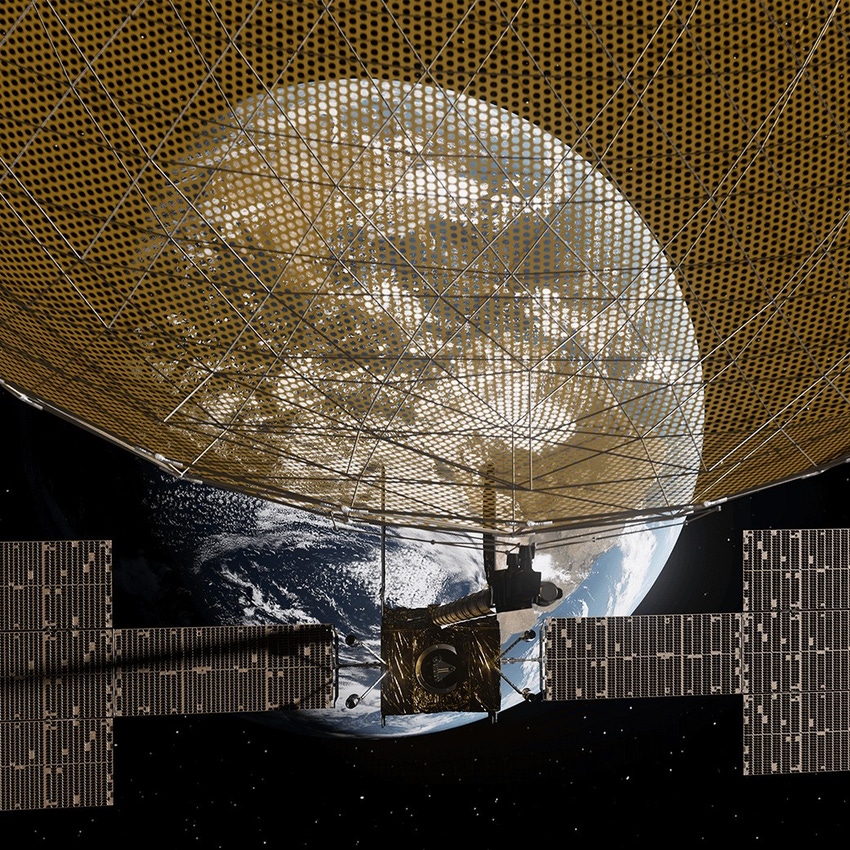
Viasat's plans to provide global broadband coverage took a step forward Sunday night with the launch of the first of three high-capacity ViaSat-3 satellites.
The ViaSat-3 Americas satellite launched Sunday night from NASA's Kennedy Space Center in Florida aboard a SpaceX Falcon Heavy rocket. The satellite is set to deploy its solar arrays and make its way to its final orbital location (88.9 degrees west longitude) – a journey that's expected to take less than three weeks.
Figure 1:  A rendering of ViaSat-3, a high-capacity satellite that packs about 1 terabit per second of capacity and weighs in at about six metric tons.
A rendering of ViaSat-3, a high-capacity satellite that packs about 1 terabit per second of capacity and weighs in at about six metric tons.
(Source: Viasat)
Viasat said the satellite is on target for a service launch by mid-2023, with details about new residential and business services plans to follow. The Boeing-made, Ka-band-based ViaSat-3 satellite will pack around 1 Tbit/s of capacity and is expected to deliver download speeds in excess of 100 Mbit/s to individual customers.
Viasat currently offers a range of speed plans for its fixed satellite broadband service. Last year, it launched a handful of "New Choice" residential service plans starting at 25 Mbit/s downstream on up to a high-end tier that delivers up to 150 Mbit/s downstream and about 3 Mbit/s upstream.
The first ViaSat-3 satellite will provide coverage to the Americas. Future ViaSat-3 satellites are poised to provide coverage to the EMEA (Europe, the Middle East, and Africa) and the Asia-Pacific (APAC) regions. Combined, they'll provide "near global coverage for land, air and sea," the company said. Viasat has been asked for an update on the planned launch timing on the other two ViaSat-3 satellites.
Figure 2:  As this rendering shows, the company's grand plan is to provide global coverage with a set of ViaSat-3 satellites.
As this rendering shows, the company's grand plan is to provide global coverage with a set of ViaSat-3 satellites.
(Source: Viasat)
Opening up capacity for home satellite broadband
Viasat's residential subscriber business has been in a holding pattern as it used available satellite broadband capacity to fuel its growing in-flight connectivity business. The launch of ViaSat-3 will provide more capacity and enable the company to focus again on the growth of its residential, fixed broadband business.
Viasat has not released residential subscriber figures for several quarters. In fiscal Q3 2023 results issued in February, Viasat said it did see a decrease in residential subscribers in the US, but noted that figure was partially offset by higher average revenues per unit (ARPU) for fixed broadband.
Viasat's total satellite services revenues in the period dropped 2%, to $302 million. That category includes Viasat's expanding in-flight connectivity services, which ended the period with 2,110 aircraft in-service.
"One of the things that's most exciting about getting ViaSat-3 on a global basis is … we can just plug into existing models, especially in in-flight connectivity," Viasat Chairman and CEO Mark Dankberg said on the call.
As it prepares to light up the capacity offered with the ViaSat-3 Americas satellite, it's not clear how aggressively Viasat intends to participate in the coming $42.45 Broadband Equity, Access, and Deployment (BEAD) program. But the company did express in its fiscal Q3 investor letter (PDF) that there "are still an estimated 10 to 15 million US homes that are candidates for high speed, high bandwidth satellite services." Amplifying its focus on rural regions, Viasat recently teamed up with Microsoft to support Airband, an initiative to provide connectivity to unserved areas around the globe, including the US.
The first ViaSat-3 bird is reaching orbit amid other changes at the company. Former Verizon exec K. Guru Gowrappan was appointed president of Viasat last month. Gowrappan, the former CEO of Verizon Media Group, is heading up Viasat's global operations and focusing on the company's broader growth strategies.
ViaSat-3 launch follows string of delays
ViaSat's first ViaSat-3 launch has been delayed. After an earlier plan to put the first ViaSat-3 satellite into service by the end of 2022, Viasat later pushed that out to early 2023, and then moved it to the week of April 8.
Like much of the rest of its satellite fleet, the ViaSat-3 constellation relies on geosynchronous (GEO) satellites stationed thousands of miles above the Earth's surface. That compares to the low Earth-orbit (LEO) approaches of SpaceX's Starlink, OneWeb and Amazon's developing "Kuiper" project, that require hundreds or thousands of satellites but provide lower latencies than GEO-based architectures.
Related posts:
Former Verizon exec named president of Viasat (press release)
— Jeff Baumgartner, Senior Editor, Light Reading
About the Author(s)
You May Also Like












